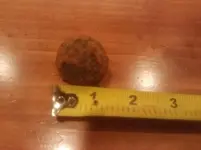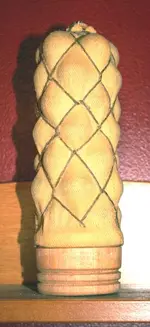Before I say anything else, I must mention that your statement that your iron mystery-ball was found about 2 miles from a Revolutionary War battle site is the foundational basis for everything else I tell you in this post. If it was found at a place where no artillery ammo was ever used (or stored), there is almost zero possibility that it is an Artillery ball.
It is indeed too large to be a "gun" (pistol/rifle/musket) projectile... but is the right size to be a particular version of cannon-ammo projectile. Also, "gun" ammo from prior to the 20th-Century was always made of lead, but your ball is made of iron. Ripcon was on the right track when he suggested it might be a cannon Canister-ammo ball... except that at the time of the Revolutionary War, what was called Canister during the civil war did not yet exist. Canister's equivalent during the Colonial Era was called Quilted Grapeshot... which was a "stack of balls" (either iron or lead) contained inside a canvas-or-other-fabric bag which had a wooden or iron base, with the balls stacked around a central shaft. The fabric bag was sewn or wrapped in a net of wire to keep it in the proper shape, which is where the term "quilted" comes from. See the photo below.
Because your iron ball appears to be just slightly larger than 1"-diameter in your photo, it is most probably from a "small-caliber" cannon's Quilted Grapeshot, such as a 4-Pounder (3.25" bore diameter) or 6-Pounder (3.67" bore diameter) cannon.
But... as I indicated above, you'll need to check to see whether or not a cannon was present at the battle near where you found the ball. No cannon there means no cannon ammo was there... which would exclude your iron ball from being an artillery-ammo ball.





